Second in continuing series, in which I cover a short topic of which I’ve read enough to be interesting but fall far short of expertise. I am sharing here in case you may find this interesting as well.
My father’s mother’s family were British but had a huge presence in Mexico. My grandmother’s sister, Helen Pope Hart (1921 – 2015) was born in Mexico City and was married to James C. Hinton for 63 years. She spent time between Cuernavaca, where my grandparents retired, and northern Mexico. This post is about the Hintons. The mathematicians, educators, writers, scientists, and artists.
(TL;DR version: the son of the man who invented the baseball pitching machine invented the jungle gym; a guy who passed the Turing test in 2018 was the great-great-grandson of the guy who invented the logic used by all modern computers; and daughter whose mother founded one of the most significant freethinking schools in the US was an Olympic skier who quit the Manhattan project to help with agriculture in China. Plus knighthoods, bugs, philanderers, painters, plants in Mexico, the invention of the tesseract, and an undecipherable codex from 1404.)
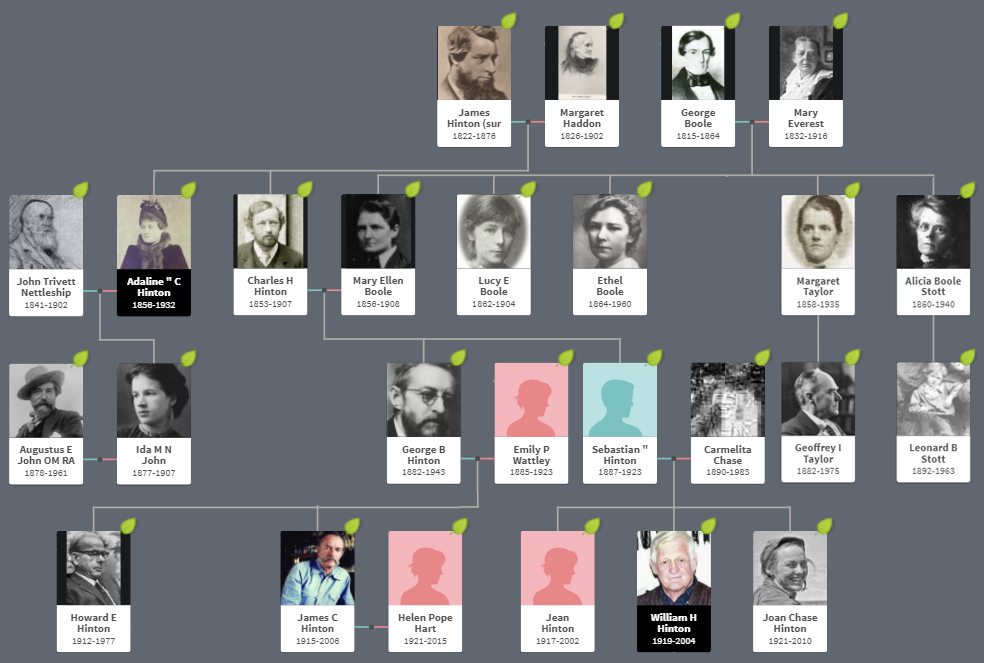
[from Left to Right, Bottom to Top — click to enlarge]
Howard Everest Hinton (1912 – 1977), was and entomologist who dedicated his life to the study of beetles. He came up with the idea of the pharate stage, part of an insect metamorphosis in which the insect has produced a new exoskeleton in preparation for ecdysis. Based on his study of water beetles in New Guinea and Australia, he was an early proponent of continental drift — which was largely rejected in the 1950s.
James Cottrell Hinton (1915 – 2006) was a botanist who collected specimens in Mexico between the years 1937-1996. In Mexican Life magazine of May 1939, Jaime relates that when he was 23 years old, at the request of his father, George Hinton, he abandoned his university studies in economics in Canada two years before finishing and returned to Mexico to support him in botanical explorations. With his father, he identified over 200 new plant species. He published dozens of short stories and five novels, sometimes under the pseudonym Andrés Mendoza. In his honor the species Lupinus jaimehintonianus is named after him.

Jean Hinton Rosner (1917 – 2002) was a civil rights pioneer and peace activist.
William Howard Hinton (1919 – 2004) was a preeminent expert on the Communist Revolution in China. He worked for the U.S. Office of War Information after WWII and was subsequently blackballed during the McCarthy era for this close ties to China. As such, he worked as a truck driver and farmer for 15 years until his academic standing was reestablished and he wrote the book Fanshen, based on his experience with Communist Land Reform in China in the 1940s. Later he wrote a documentary, Shenfan, speaking out about the socialist market economy of Deng Xiaoping.
Joan Chase Hinton (1921 – 2010), was a world class skier who was set to compete at the cancelled 1940 Olympics. When the games were cancelled, she turned her attention to working as a nuclear physicist on the Manhattan Project in Los Alamos. She calibrated neutron detectors used in the Alamogordo test. She was shocked when the US dropped nuclear bombs on Hiroshima and Nagasaki three weeks later. She left the Manhattan Project and eventually joined her brother in China where she worked on developing a socialist economy, working extensively in agriculture.
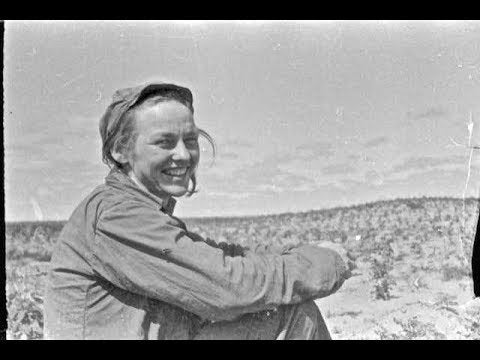
Augustus John (1878 – 1961) was a Welsh painter, briefly considered the best of his contemporaries. Virginia Woolf would remark that by 1908 the era of John Singer Sargent and Charles Wellington Furse “was over. The age of Augustus John was dawning.”
Ida Margaret Nettleship (1877 – 1907) was an English artist and the first wife of artist Augustus John. Her granddaughter, Rebecca John, published Ida’s letters in The Good Bohemian.
George Boole Hinton (1882 – 1943) was a botanist and mining engineer. He held several patents for improvements in cellular concrete. As an avid plant collector, he found 2 new genera and 116 new plant species in Mexico.
Sebastian “Ted” Hinton (1887 – 1923) lived in Japan as a child. To teach his children math skills, his father, Charles Howard Hinton built a three-dimensional bamboo grid with evenly spaced cubes his children could climb upon. He would shout Cartesian coordinates “X2! Y4!” and watch his kids race to the point. He settled in Chicago and married Carmelita Chase, who taught school in nearby Winnetka. Although he was an attorney by trade, in 1920 he built her class a metal structure to play on, like the bamboo one his father made. He invented the “Junglegym.”

Carmelita Hinton (1890 – 1983) met her husband while working for Jane Addams, social activist and suffragist, and first American woman to be awarded the Nobel Peace Prize. Based on the the principles of the Progressive Education movement, she founded Putney School (graduates include Errol Morris, Carlton Cuse, and at least a few Kennedys) in Battleboro, Vermont.
Sir Geoffrey Ingram Taylor (1886 – 1975) [son of Margaret Taylor] was a British physicist and mathematician, and a major figure in fluid dynamics and wave theory. His biographer and former student, George Batchelor, described him as “one of the most notable scientists of this century.”
Leonard Boole Stott, (1892 – 1963) invented a portable X-ray machine, an artificial pneumothorax apparatus, and a
system of navigation based on spherical geometry. He was also a medical doctor, and a pioneer in the treatment of tuberculosis.
John Trivett Nettleship (1841 – 1902) was one of nineteenth-century Britain’s leading animal illustrators. His sketches, pastels, watercolors, and oil paintings in were highly respected by critics, collectors, and the public from his first exhibition in 1871 until his death in 1902. He was the brother of classics scholar Henry (who helped establish Oxford women’s college), ophthalmologist Edward (who made important contributions in the research of ocular albinism, retinitis pigmentosa and hereditary night blindness), and philosopher Richard (a noted Plato scholar),
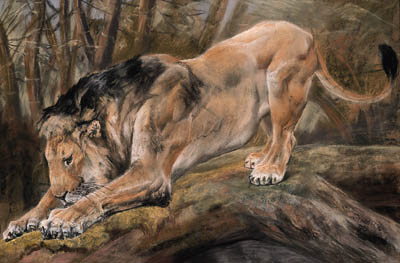
Adaline “Ada” Cort Nettleship (1856 – 1932), Charles’ sister, was a sought-after theatrical costumer. Her designs, were admired by the London avant-garde, exemplified the Aesthetic style. In 1883 she presented a “Ladies Walking Costume” that included trousers, a feature that allowed for radical shortening of the overskirt for a landmark exhibition by the Rational Dress Society. This was more than two decades before European women started wearing trousers in public.
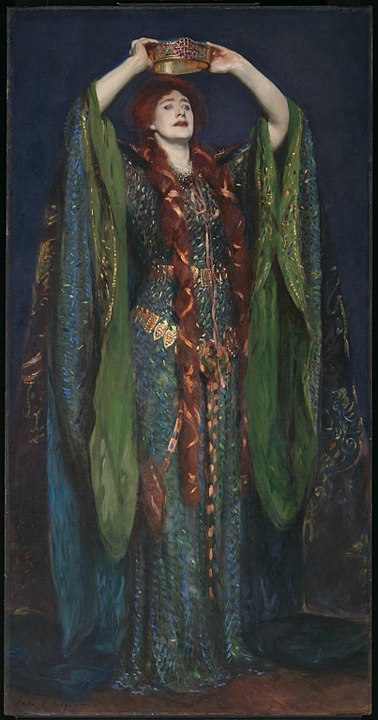
Charles Howard Hinton (1853 – 1907), born in England, published an early paper on his theories about the 4th dimension and coined the word (among others that describe direction in the 4th dimension) tesseract. In 1884, he wrote the definitive article on the subject (at the time) “What is the Fourth Dimension?” He wrote, “If we think of a man as existing in four dimensions, it is hard to prevent ourselves from conceiving him prolonged in an already known dimension.” Hinton used a four-cornered room, or cube, for example, to explain how one can only reach three dimensions. “Space as we know it, is subject to limitation,” he conceded. He was mentioned in works written by Argentine essayist Jorge Luis Borges, comic writer Alan Moore, and occultist Aleister Crowley. As as instructor of mathematics at Princeton University, he invented the first baseball pitching machine.
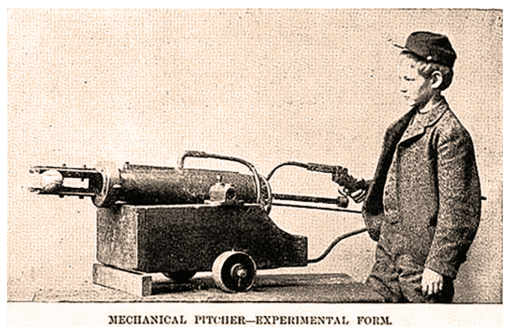
Mary Ellen Boole (1856 – 1908) wrote a book of poems and gave lectures about modern poetry.
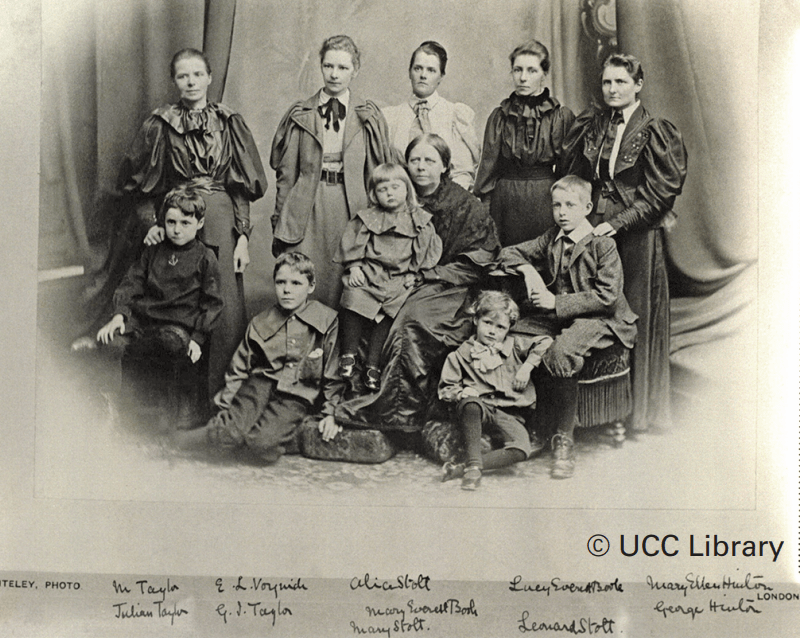
Back row: Margaret Taylor, Ethel L Voynich, Alicia Boole Stott, Lucy E Boole, Mary E Hinton
Seated: Julian Taylor, Mary Stott, Mary Everest Boole, George Hinton
In front: Geoffrey Ingham Taylor, Leonard Stott
Lucy Everest Boole (1862 – 1904) was an Irish chemist and pharmacist who was the first woman to research pharmacy in England. She was the first female professor at the London School of Medicine for Women in the Royal Free Hospital, and the first female Fellow of the Royal Institute of Chemistry. Her mother summarized her career: “Lucy Everest Boole: never at any college. Learned Chemistry in order to qualify as dispenser or shop assistant in pharmacy. Became Fellow of the Institute of Chemistry, Lecturer in Chemistry and Head of Chemical Laboratories at London School of Medicine for Women.”
Ethel Lilian Boole Voynich (1864 – 1960) was a novelist and musician, and a supporter of several revolutionary causes. Voynich was a significant figure, not only on the late Victorian literary scene, but also in Russian émigré circles. She is best known for her novel “The Gadfly,” which became hugely popular in her lifetime, especially in Russia. Her husband, Wilfrid Michael Voynich was (among other things) an antiquarian book dealer, giving his name eventually to the enigmatic Voynich manuscript. Minor planet 2032 Ethel, discovered in 1970 by Soviet astronomer Tamara Mikhailovna Smirnova, is named after her.

At the age of eighteen, Alicia Boole (1860 – 1940), was introduced to a set of little wooden cubes by her brother-in-law Charles Howard Hinton. Hinton was using them to prepare for an article about the fourth dimension. Boole experimented with the cubes and soon developed an amazing feel for four dimensional geometry. She introduced the word ‘polytope’ to describe a four dimensional convex solid. According to her biographer, “She found that there were exactly six regular polytopes on four dimensions and that they are bounded by 5, 16 or 600 tetrahedra, 8 cubes, 24 octahedra or 120 dodecahedra. She then produced three-dimensional central cross-sections of all the six regular polytopes by purely Euclidean constructions and synthetic methods for the simple reason that she had never learned any analytic geometry.” In 1888 she wrote part of the preface and of the chapters on sections of 3-dimensional solids of her Hinton’s book “A new era of thought.”
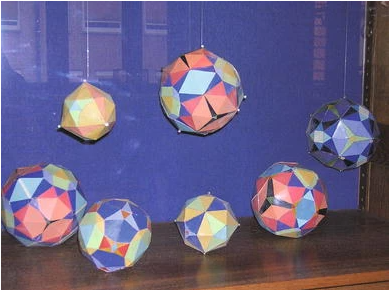
James Hinton (1822 – 1875) was arguably one of the most skillful surgeon of his day, an outspoken advocate of polygamy, and was possibly an influencer of Jack the Ripper. An introduction to his published letters was written by Sir William Withey Gull, a man thought by some to possibly be Jack the Ripper.
George Boole (1815 – 1864) was a largely self-taught English mathematician, philosopher and logician, most of whose short career was spent as the first professor of mathematics at Queen’s College, Cork in Ireland. He worked in the fields of differential equations and algebraic logic, and is best known as the author of The Laws of Thought (1854) which contains Boolean algebra. Boolean logic is credited with laying the foundations for the information age. Quite simply, you would not be reading this here if not for the work of George Boole.
Mary Everest Boole (1832 – 1916) also a self-taught mathematician who is best known as an author of didactic works on mathematics, such as “Philosophy and Fun of Algebra.” Her progressive ideas on education, as expounded in The Preparation of the Child for Science, included encouraging children to explore mathematics through playful activities. Mary encouraged the use of mathematical imagination with critical thinking and creativity. Her life is of interest to feminists as an example of how women made careers in an academic system that did not welcome them.
Not Pictured
Colonel Sir George Everest (1790 – 1866) [uncle of Mary Everest Boole] was a British surveyor and geographer who served as Surveyor General of India from 1830 to 1843. He is best known for having Mount Everest, the highest mountain on Earth, named in his honour.
John Howard Hinton (1791 – 1873) [father of James Hinton] was an English author and Baptist minister who published, along with many other works, The History and Topography of the United States of North America together with his brother Isaac Taylor Hinton (1799 – 1847).
Geoffrey Everest Hinton (1947 – ) [son of Howard E. Hinton] Turing Award winning cognitive psychologist and computer scientist, most noted for his work on artificial neural networks. Hinton, Yoshua Bengio, and Yann LeCun are referred to as the “Godfathers of AI” and “Godfathers of Deep Learning.”
Carma Hinton (1949 – ) [daughter of William H. Hinton] is a Peabody-winning documentarian and Professor of Visual Culture and Chinese Studies at George Mason University.
References
The Hintons’ legacy to the knowledge of the flora of Mexico
https://www.researchgate.net/figure/From-left-to-right-George-Boole-Hinton-James-Hinton-and-George-Sebastian-Hinton_fig1_335551305
Hinton Family
https://en.wikipedia.org/wiki/Category:Hinton_family
Alicia Boole Stott (1864-1923)
https://mathshistory.st-andrews.ac.uk/Biographies/Stott/
Those Amazing Boole Girls
https://pballew.blogspot.com/2014/10/those-amazing-boole-girls.html
Charles Howard Hinton, the ‘Other Dimension,’ and the Birth of the Jungle Gym
https://unrememberedhistory.com/tag/jungle-gym/
